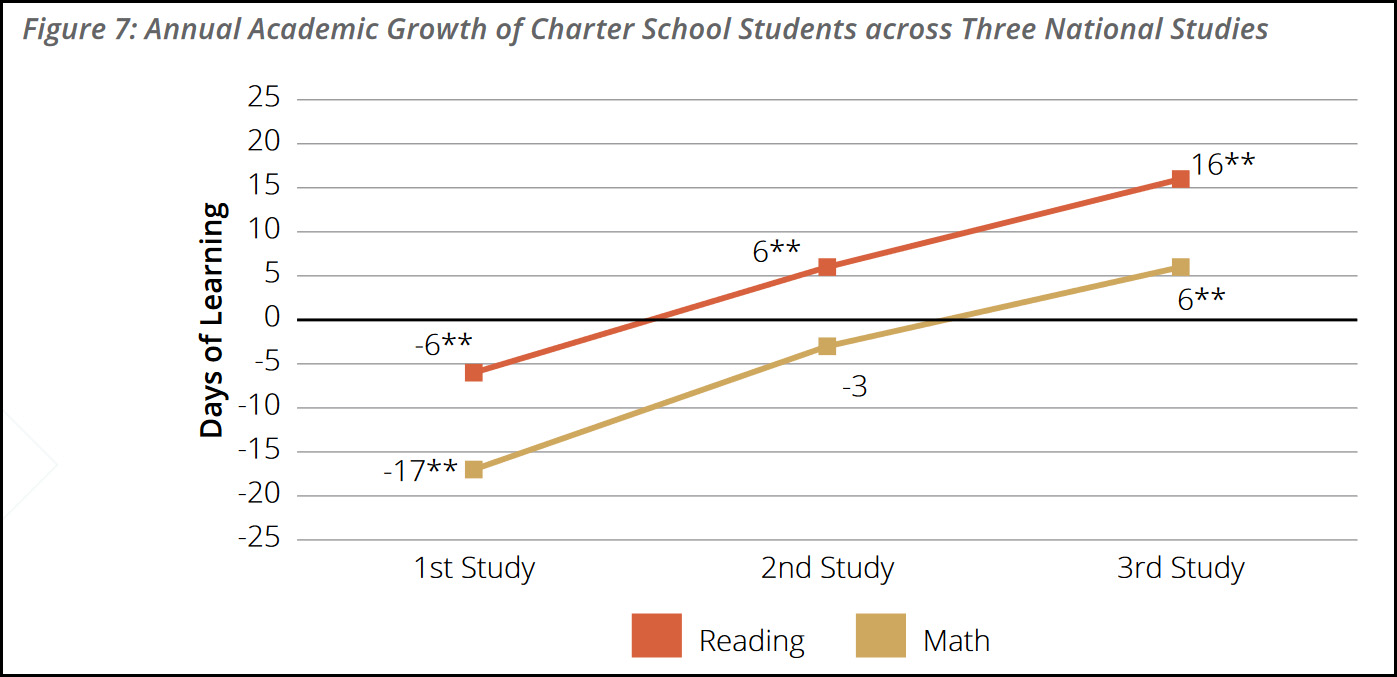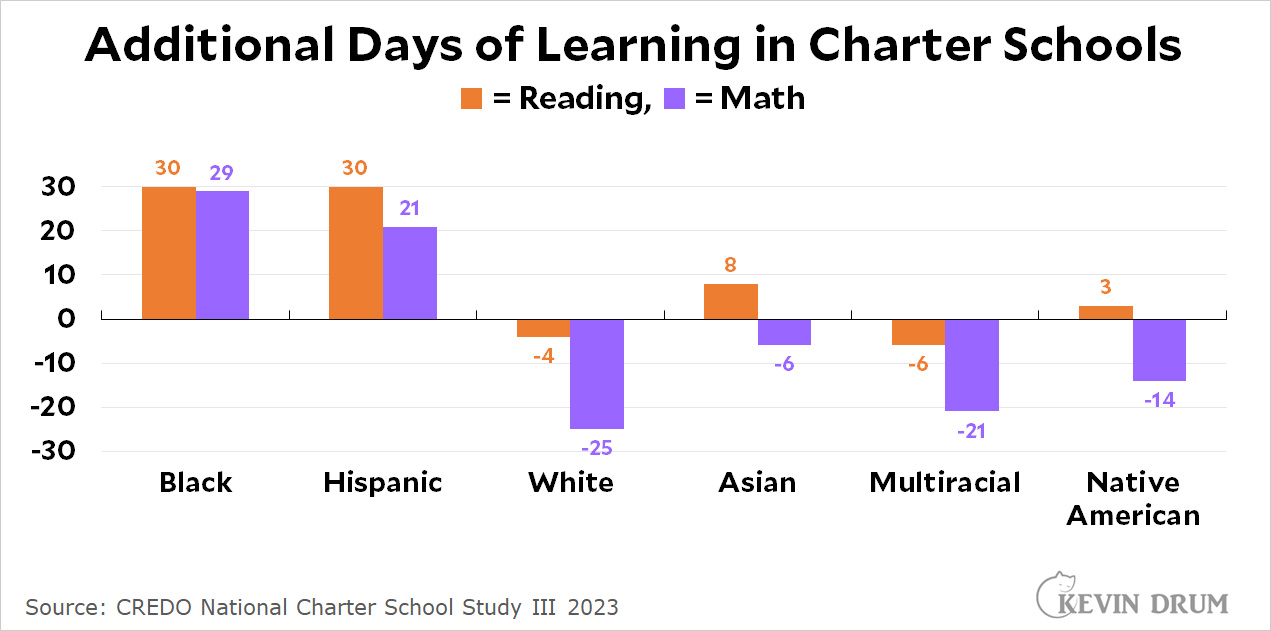The third edition of CREDO, a study of charter school performance, was released today. It covers the years 2014-2019 and shows much stronger performance for charter schools than the previous two studies:
 Performance is measured here in "days of learning," with 180 days as the baseline. The latest study shows that in reading, charter students average 16 more days of learning compared to public school students. In math the difference is 6 days.
Performance is measured here in "days of learning," with 180 days as the baseline. The latest study shows that in reading, charter students average 16 more days of learning compared to public school students. In math the difference is 6 days.
But these averages conceal an astonishing difference by race. Charter schools are good for Black and Hispanic students but not for anyone else:
 Generally speaking, the study shows positive charter results for:
Generally speaking, the study shows positive charter results for:
- Black and Hispanic students
- Students in poverty
- Urban students
- Schools in northeastern states
- Charter Management Organizations (CMOs)
Results outside of these areas can be quite different from the averages. For example, Ohio charters showed -4% growth in reading and -38% growth in math compared to local public schools. Nationally, children not in poverty showed only small growth in reading and no growth in math. Standalone charters (not part of a CMO) showed a small fraction of the growth of CMO charters. Special education students showed negative results in both reading and math.
It's not clear why the results line up this way. Poor urban charters are probably almost entirely Black and Hispanic, so the strong results for these groups are likely because urban charters are systemically different from suburban charters in some way. The report doesn't speculate about what this difference might be, and I don't have any guesses myself. Perhaps urban charters tend more toward the "no excuses" philosophy than suburban charters?

"Perhaps urban charters tend more toward the "no excuses" philosophy than suburban charters?"
How tightly the rope is grasped depends on whom you're throwing the rope to.
Drowning people score high on this metric.
I'm going to guess that there is a lot of selection going on. Urban charters are pulling in poor parents who are more stable than average (harder to get your kid into a charter when you are constantly moving, addicted to drugs, mentally ill, etc.). Kids in charters who are hard to handle or have learning difficulties get pushed out to the public schools who can't say no.
In the burbs the charters are more about boutique learning experiences, so you aren't attracting parents the same way as you do in the inner city (instead of fleeing falling-apart public schools, parents are actively seeking outdoor science, nongendered bathrooms, more recess, etc., which are nice, but affect test scores less). And the burbs have far fewer students with parents who are both poor and dysfunctional, so the average public school kid would do just fine anywhere.
Yeah, I think this is it. If you’re worried about your kid’s educational environment and can’t afford either private tuition or to live near a “good” school, magnets and charters are the only real boosts you can provide.
I've been teaching in Los Angeles schools for 17 years. I've worked at three high schools and one middle school. My experience pretty much matches what you are saying.
My best guess:
Urban charters cater to students who want to escape poverty.
Suburban charters cater to students who want extra attention.
It's difficult to measure this with incoming test scores, especially if those test scores are for young students.
Sounds like it's time to bring back segregation so we can provide the best educational experience to each bucket.
Some of that is how schools are regulated. One reason to attack "gov't schools" is so private businesses can get a piece of the action....
As for this study, if I'm reading it right, it's comparing each group to a "traditional public school" reference group, so not to each other. Groups that are not doing so well in traditional public schools may see more upside going to a good charter school than say, someone coming in from groups that are doing pretty well already. A little cherry picking, and traditional public schools won't look as good so the charter school looks better by comparison.
Dailyhowler commentary would be welcome here but he is currently debunking the Mississippi educational miracle. Based on his own personal experience as a former Baltimore school teacher, his take on such numbers like those shown here is to be wary of fast improvements. I think something that nobody mentions is that when you remove the top 10% performers of an inner city school system, you lose more than their test scores, you also lose a culture of people who care allowing mediocrity to be accepted as the norm, essentially creating a downhill spiral where no one cares, and if you do, you are chastised, and thus widening the gap between the schools. Meaning that the overall results actually worsen.
I’m suspicious myself, but that’s because I’m originally from Mississippi, which is a mountain of white entitlement capped with bullshit.
Additional days of learning do not necessarily translate into additional learning. This study is only about extra classroom days, not about results. Drum does not seem to recognize that and treats these days as if they were somehow a measure of improvement in performance.
TDH did not manage to actually discredit the results in MS. It is odd that he would try given that the MS "miracle" was supported by NAEP test improvement and based upon major changes in how teachers are trained and how reading is taught, increased funding and a great deal of hard work over a decade. The improvement is in comparison to the state's own past results. TDH is mainly upset because the considerable improvement measure by NAEP was referred to as a "miracle". The pride in the improvement seems justified and TDH has found nothing to undermine that, despite a whole lot of effort by TDH to make it seem like nothing has happened. Why would someone go to that effort instead of being happy for the state and its kids?
I think you misunderstand TDH. They aim is not to discredit but to understand how improvements happened. His analysis for the state is not complete but we already know that the state drastically increased the number of failing third graders who had to repeat the grade (a controversial move). The latest Naep test results are the first under the new policy. Comparing the test results with the prior results is comparing apples and oranges. If every state did what Mississippi did, their test results would go up by the same margin. It is a way of rigging the test results and not evidence of improvement.
I wonder what the makeup of the classrooms are beyond the racial distinction.
How many students per classroom? How many teacher assistants? Availability of focused teaching for those needing assistance and those needing more challenging work?
Some basic factors which should have obvious impact.
I wasn't able to find the "Technical Appendix" that the report says describes the statistical analyses in detail, but I was able to find it for the 2013 study. It doesn't sound like a lot has changed method-wise.
A couple things bug me a bit:
1. No confidence intervals. It doesn't seem a stretch to think that their matching method could produce CIs under some parameter. Would be nice, considering that the match process working is critical to the analysis.
2. There's an awful lot of subgroup slicing, and unless I'm misreading the 2013 Technical Appendix, the authors' response to reviewer objections regarding multiple comparisons is more or less "we don't think it's a concern." That's ... hmm.
3. Everything rides on the validity of their student matching method. I'll readily admit that I didn't have time to read the couple of small-scale validity comparisons they point to, so this might in fact be just fine.
I get that just throwing up one's hands and saying "well there's no way to conclude anything because our data sources aren't great and the effect sizes are small" isn't really an option when trying to decide on policy. And of course any study can and will attract any number of statistical quibbles.
But given the above it's awfully easy to imagine that the subgroup effects are not meaningful or even real.
+1. P-hacking is a thing, even if you don't know you're doing it.
What I wouldn't give to be able to respond to reviewer objections with a simple "nah"!
Could it be that urban charters are less like urban public schools and suburban charters are more like suburban public schools? Aren't a lot of urban charters associated with programs like KIPP, which is selective and have developed high powered curricula.
Is it that the white students in charter schools are in some kind of wingnut 'leadership' and religious maniac academies, while the black and Hispanic students have parents who really want them to succeed and get them into a better environment?
"Poor urban charters are probably almost entirely Black and Hispanic, so the strong results for these groups are likely because urban charters are systemically different from suburban charters in some way. "
Are you sure the difference isn't in the charters but the control?
40 schools are now accepting garbage as tuition fees in Lagos,
https://ncbna.org/nigeria-40-schools-are-now-accepting-garbage-as-tuition-fees-in-lagos/
A rough suggestion - it might simply be that non -urban public schools are better funded and in many cases provide an excellent education for enrolled students. Urban public schools underperform to such a great extent that any other option is likely to produce better math and reading outcomes.